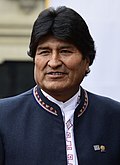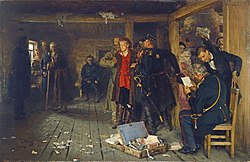Populism
Populism is a name for a kind of political movement. Populists usually try to make a difference between common people and "elites" (meaning usually, top classes of people). Populists may think of wealthy people or well-educated people as belonging to the class of elites. Populists may also call those who have been working in government for a long time "establishment" and count them as elites too. A theme of populism is that the common people lack certain privileges that the elites have, or that commoners cannot do certain things the elites can do. The populists see themselves on the side of the common people. They want to help the common people get some of the rights and privileges of the elites.
Right-wing populism
Right-wing populists take some of the values of right-wing parties:
- They see unregulated immigration as good for the elite and bad for the people.
- They are against globalization and foreign beliefs: In Europe, they often think that European values are based on Christian ones, and that other religions or their values are bad.
Left-wing populism
Left-wing populists share some of the values of left-wing parties:
- They believe in social justice, according to their defined definition
- Often, they are against capitalism and globalization
- Unlike right-wing populists who are against unregulated immigration, they focus heavily on including unprivileged social groups. Often at the burden of a larger collective.
Left-wing populism is common in Central and South America.
Populism Media
The Bolivian government of left-wing populist Evo Morales and his Movement for Socialism has been described as the "prototypical case" of ethnopopulism.[1]
Protesters from the Tea Party movement, a right-wing populist formation in the United States
The Argentine political theorist Ernesto Laclau developed his own definition of populism. He regarded it as a positive force for emancipatory change in society.
A 2012 rally by members of the left-wing populist United Socialist Party of Venezuela in Maracaibo
"Hear the wrath of the people", a member of the Indignados, a Spanish left-wing populist movement, in Puerta del Sol, 2011
Hungarian Prime Minister Viktor Orban has been cited as a populist leader who has undermined liberal democracy upon taking power.[2]
Nazi Party rally in Nuremberg, 1936
Ilya Repin's painting, Arrest of a Propagandist (1892), which depicts the arrest of a narodnik
Jean-Marie Le Pen, founder and leader of the French National Front, the "prototypical radical right party" which used populism to advance its cause[3]
Related pages
- Appeal to popularity
- Autocracy
- Cult of personality
- Ochlocracy
- Pragmatism
- Political polarization
- Welfare state
- ↑ Mudde & Rovira Kaltwasser 2017, p. 72.
- ↑ Mudde & Rovira Kaltwasser 2017, p. 91.
- ↑ Mudde & Rovira Kaltwasser 2017, pp. 34–35.











